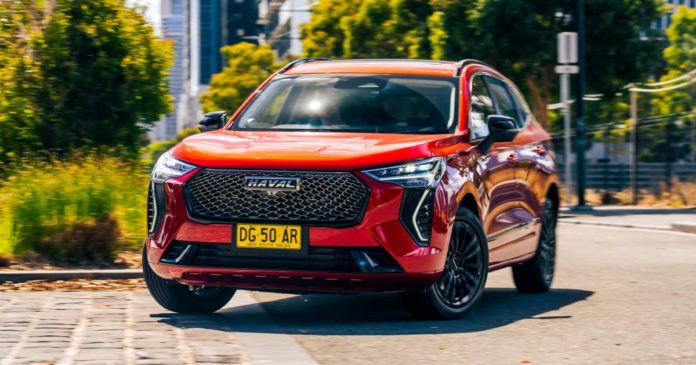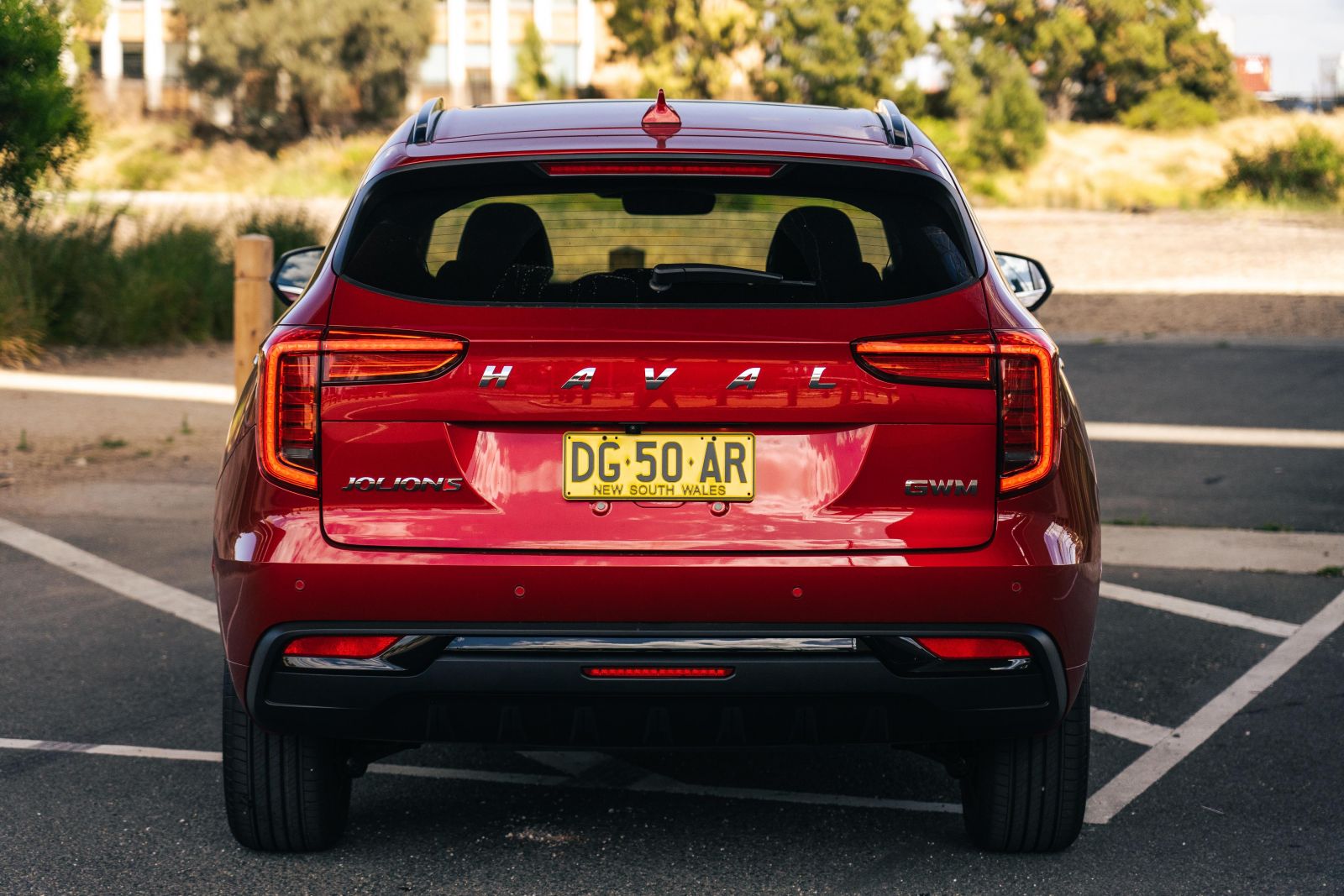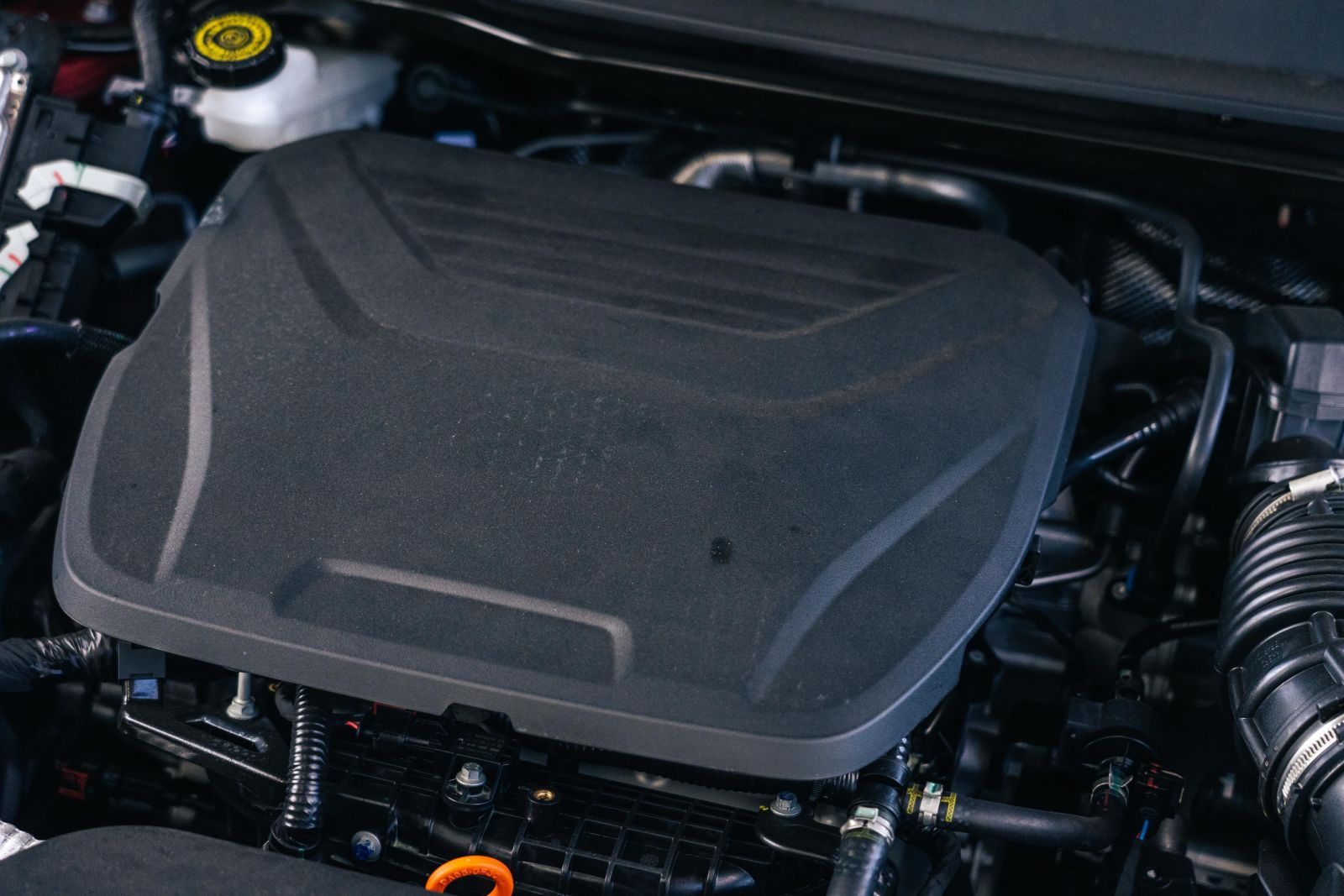GWM Haval Australia has added some S-pice to the increasingly popular Jolion SUV.
Off the back of a very successful 2022 sales year, GWM’s local division announced the arrival of the Jolion S in late November as the new petrol flagship, bringing the line-up at the time to five variants.
The company has since added a second Jolion Hybrid variant to bump that range to six, based on the Lux trim level – priced at the same $36,990 drive-away as the S on test.
The S is not like most black packs or ‘Sport Line’ model variants, as it actually gets a beefier engine tune and more sophisticated multi-link rear suspension system compared to the wider petrol-powered Jolion range.
It should be quicker and handle better, while featuring some black pack-style exterior appointments to give a more athletic look.
It’s also got a revised panel of buttons ahead of the touchscreen infotainment system for better ease of use compared to the touch panel used elsewhere in the range. Otherwise, that’s the extent of the S-specific appointments.
Is this the new sweet spot?
How much does the GWM Haval Jolion S cost?
The Jolion S is priced from $36,990 drive-away, making it $3000 dearer than the previous petrol flagship, the Ultra.
Even with recent price adjustments across the range, the Jolion is still very competitively positioned in the Small SUV segment, aligning top-spec models with low- and mid-spec versions of rival models.
The Jolion S is less money than a one-from-base Mazda CX-30 G20 Evolve (around $37,170 D/A), and is nestled between the advertised drive-away prices of the Kia Seltos Sport FWD ($35,390 D/A) and Sport+ FWD ($38,490 D/A).
Arguably the Jolion’s most direct rivals are fellow budget-focused sport pack SUVs in the MG ZS T Essence ($33,990 D/A) and the Mitsubishi ASX GSR ($35,340 D/A), both of which offer a similar athletic theme to the Jolion S.
While the price gap between the S and its competitors isn’t as wide as variants lower down in the range, it’s still mighty sharp given the quoted outputs and the space on offer – more on that in a bit.
2023 GWM Haval Jolion pricing:
- Jolion Premium: $28,490
- Jolion Lux: $30,990
- Jolion Ultra: $33,990
- Jolion S: $36,990
- Jolion Lux Hybrid: $36,990
- Jolion Ultra Hybrid: $40,990
Prices are drive-away
What is the GWM Haval Jolion S like on the inside?
Much like the Jolion Ultra, with one main difference that won’t be immediately obvious.
While there’s been some tinkering with the exterior and oily bits, the interior of the Jolion S is largely identical to that of the Ultra that’s been on sale locally for a number of years.
The only difference is a new panel of hard buttons under the touchscreen for functions like fan speed, A/C, de-mister and air recirculation. It’s an improvement on the touch-capacitive controls in other models, but we still want physical temperature controls as well.
You still have to use the touchscreen to adjust the temperature on the move. I know you can just set and forget, but given how big that 12.3-inch touchscreen is it can be a bit of a reach to find controls on the passenger side of the screen.
The driver’s seat is powered, but seems limited in its adjustment. You can’t adjust the angle of the seat base, nor is there a lumbar option. Additionally, the steering wheel adjusts for height, but not for reach.
I know everyone is different, and I’ve had plenty of owners say they’re more than happy with the Jolion’s seating position. However, my tall and leggy frame feels under supported.
My lanky limbs mean I have to sit fairly far back, but my shorter torso also means I like to have the steering wheel out further from the dash. In the Jolion, I have to sit closer than is comfortable and mean my knees are a little off the seat base, or I’m left feeling like my arms are stretched out more than usual.
I wasn’t a fan of the driving position in the larger H6, even with added adjustment in both the seat and steering wheel.
Build quality feels pretty solid – don’t think it’s cheap just because it’s Chinese. Everything feels well screwed together, and the presentation on first glance is competitive for the class. However, there are a lot of hard plastics including the door tops and upper dashboard, though there is a nice padded insert for the main dash fascia.
The 12.3-inch touchscreen is familiar, and features wired Apple CarPlay and Android Auto but not embedded satellite navigation like most rivals. It also lacks DAB radio, which is quickly becoming more common.
If you’re used to plugging in for smartphone mirroring you should be fine, but if you’re the type that uses embedded systems and digital radio, you may be left feeling short changed. At least the wired Apple CarPlay connection worked reliably during my time with the car.
Vehicle functions and settings are also embedded in the touchscreen, which while clearly labelled can feel convoluted. There are some bits that feel like average translations from Chinese to English.
The heated seats and temperature, for example, are only adjustable through the touchscreen and toggling various driver assistance settings requires diving through settings menus. Thankfully, there’s a quick-access swipe-up menu for some basic settings, though it requires you exiting smartphone mirroring or going back in.
At least the surround camera display looks excellent, with a 3D projection that wouldn’t look out of place in a BMW.
Arguably one of the Jolion’s strongest traits is its rear seat packaging and large boot.
Even at 6’1 I can sit behind my own driving position with plenty of room to spare. That can’t be said for a lot of rival vehicles in this segment.
Two adults will comfortably fit in the rear, three at a squeeze. Kids should be more than fine, with big windows, as well as the requisite ISOFIX and top-tether points for child seats.
You also get rear air vents, USB charge ports behind the centre console, rear map pockets, bottle holders in the doors, and a fold-down centre armrest with extra cupholders.
Behind the second row is a 430-litre boot area, which is up there with some of the largest in the segment. Petrol models quote a little more than the hybrids, which offer 390L due to the hybrid battery being under the boot floor.
Drop the rear seats and that expands to a healthy 1139 litres, with a fairly flat load area and no step up from the cargo floor to the seat backs. Props to GWM Haval for packaging this so well.
Unfortunately the Jolion can’t match rivals like the Kia Seltos in featuring a full-size spare wheel under the boot floor, though it does offer a space-saver.
What’s under the bonnet?
The Jolion S features an uprated version of the 1.5-litre turbocharged four-cylinder petrol engine fitted elsewhere in the range.
Developing 130kW and 270Nm, the S is 20kW and 50Nm up on the standard range, which should translate to enhanced performance – though GWM Haval hasn’t quoted a 0-100km/h time.
As with the wider petrol range, the Jolion S sends drive to the front wheels exclusively via a seven-speed dual-clutch automatic transmission.
Despite being more powerful, the Jolion S is more efficient than other petrol-powered models according to the brand. GWM quotes a combined consumption rate of 7.5L per 100km, which is 0.6L/100km less than the standard versions.
All versions of the GWM Haval Jolion are fitted with a 55-litre fuel tank, and are compatible with 91 RON regular unleaded fuel.
Further to the drivetrain changes, the S has seen the torsion beam rear suspension setup swapped out for a new multi-link rear suspension to offer “enhanced ride and handling performance befitting of the S nameplate”.
How does the GWM Haval Jolion S drive?
I was quite interested to see if the engine and suspension upgrades would translate tangibly on the road.
I last reviewed the turbo petrol Jolion Ultra a couple of years ago, and I remember finding it a little lacking in drivetrain refinement. This Jolion S felt more resolved.
From the moment you set off it feels as if some work to the transmission calibration as been done to minimise the low-speed lurching and hesitation that plagued other versions of this car, and I was actually impressed with how the S delivers its performance.
Is the GWM DCT as good as something from VW? No it’s not. Then again, the VW T-Roc R-Line with 140kW/320Nm is substantially more money to get that added performance and refinement.
In normal driving the Jolion S has decent pull from down low and isn’t particularly jerky or disjointed in traffic, though at times it can sound like it’s riding the clutch to smooth things out. Most of my week was spent driving to and from work, and it did the job just fine.
My only real gripe with it is shifting from D to R during low-speed parking manoeuvres, where occasionally it can feel like it’s dozing off or unwilling to do what you’re asking on an incline. It’s not always easy to tell when you’ve shifted into D or the Manual mode as the rotary just spins endlessly.
The steering – while I couldn’t adjust the wheel for reach – is fairly well-sorted, though doesn’t feel as connected or fluid as something like a Mazda CX-30, and the well-sorted chassis means it won’t fall apart in corners.
With that said, the S doesn’t offer a particularly sporty suspension tune, which appears to prioritise everyday comfort and compliance. It deals with pimpled city streets reasonably enough, but there is a noticeable amount of body lean if you push into a bend.
The multi-link rear suspension feels better sorted than the torsion beam, with less thudding and slapping over sharper hits. It deals with things like speed humps just fine, but successive high-speed undulations on regional freeways can upset the balance a little.
The added performance is welcome. It’s surprisingly brisk for what it is, even if the engine note under hard throttle can be a little loud and thrashy. It can also spin up the front wheels if you plant it from the lights.
You can take control of the transmission via the steering-mounted paddle shifters as well. It’s not the type of car or drivetrain that inspires you to use this often, but thankfully it’s reasonably quick to respond to inputs and doesn’t suffer from any slurring through ratios like other Haval products.
On the highway, the Jolion settles nicely and its relatively large footprint means it feels planted and confident on the open road. It’s also relatively refined, with minimal engine noise and adequate insulation from road and wind intrusion.
The Jolion features a wide range of standard driver assists that look good on paper, but have received mixed reviews from the CarExpert team. I complained about the active lane centring and adaptive cruise control in my previous review of the Jolion Ultra, as it would constantly shift between overbearing and dim-witted, over-correcting its over-corrections.
This S was better. I used the cruise assist function (adaptive cruise + lane centring) numerous times and found it way more sorted than before. Occasionally the curve speed adaption would brake harder than was necessary, but otherwise it was decent.
Also worth praising is the Jolion’s surround camera display. On the high-resolution display the camera feeds and 3D animation of the Jolion while parking are arguably class-leading.
Rounding out the assistance suite are blind-spot monitoring and rear cross-traffic alert, which aid the driver when merging lanes or navigating gaps in traffic, even with the Jolion’s decent outward visibility.
What do you get?
Jolion Premium highlights:
- 17-inch alloy wheels
- Rain-sensing wipers
- Roof rails
- Hill descent control
- Halogen headlights
- Cloth upholstery
- 3.5-inch driver’s display
- Keyless entry and start
- 10.25-inch touchscreen infotainment system
- Apple CarPlay, Android Auto (wired)
- 4-speaker sound system
- Air-conditioning
- Rear air vents
- Front, rear USB outlets
Jolion Lux adds:
- LED headlights
- Rear privacy glass
- Comfort-Tek leatherette upholstery
- 7.0-inch driver’s display
- 6-speaker sound system
- Dual-zone climate control
- Power-folding exterior mirrors
- Automatic anti-glare rear-view mirror
Jolion Ultra adds:
- 18-inch alloy wheels
- Panoramic sunroof
- 12.3-inch touchscreen infotainment system
- Head-up display
- One-touch up/down for all four windows
- Key fob window close function
Jolion S adds:
- 18-inch black alloy wheels
- Black exterior mirrors, roof rails, bumper trim
- Multi-link independent rear suspension
Colours
- Hamilton White
- Golden Black*
- Azure Blue*
- Mars Red*
- Smoke Grey*
*Premium paint costs $495 extra
Is the GWM Haval Jolion S safe?
The Jolion wears a five-star ANCAP safety rating, based on local tests conducted in 2022.
It scored 90 per cent for adult occupant protection, 84 per cent for child occupant protection, 64 per cent for vulnerable road users, and an impressive 92 per cent for safety assist.
Standard safety features include:
- 7 airbags incl. front-centre airbag
- AEB with Pedestrian, Cyclist detection
- Adaptive cruise control
- Driver attention monitoring
- Lane departure warning
- Lane keep assist
- Blind-spot monitoring
- Rear cross-traffic alert
- Traffic sign recognition
- Reversing camera
Jolion Lux adds:
How much does the GWM Haval Jolion S cost to run?
The GWM Haval line-up is covered by an above-average seven-year, unlimited-kilometre warranty.
Five years of roadside assistance is thrown in too, as well as five years of capped-price servicing. Intervals are 12 months, with 10,000km for the first year and 15,000km from there on.
For petrol Jolion models, the first five services each cost $210, $250, $350, $450 and $290 – amounting to $1550 for the first 60 months or 70,000km of scheduled maintenance. Not bad.
Real-world fuel consumption wasn’t the Jolion S’s strong point, despite quoting an improvement over the standard version.
We ended our week of testing with an indicated 9.9L/100km, 2.5 litres up on the brand’s combined claim. That’s not great considering we covered over 370km of mixed driving, including a decent portion of freeway use.
Not helping is the lack of idle stop/start, which is standard in the H6. If efficiency is a priority, I’d suggest looking at the Jolion Hybrid – the Lux HEV is priced the same as this S, which seems quite compelling.
CarExpert’s Take on the GWM Haval Jolion S
The Jolion S shapes up as the best petrol-powered version on offer – but it doesn’t come without caveats.
While the power bump, suspension upgrades and meaner look are all worthwhile, $3000 is a hard pill to swallow when it doesn’t really offer much more over the Ultra equipment-wise.
And, while I’d argue the Jolion S is objectively the best petrol variant we’ve sampled, the hybrids are the best Jolions on sale… period.
The recently-introduced Jolion HEV Lux addresses its HEV Ultra sibling’s key criticism of price, and while it misses out on the S’s and Ultra’s larger 12.3-inch central display and panoramic sunroof, its equipment list doesn’t want for much more.
Further, the Jolion Hybrid effectively halves fuel consumption based on our real-world testing (Scott managed 5.3L/100km), and resale values will likely hold stronger given our increasing demand for electrified vehicles.
GWM Haval deserves praise, however, for offering more choice, and for refining the petrol Jolion to give us this new S variant. Given the Chinese brands still trade largely on sharp pricing and value, that sparkle diminishes quickly as you move up the range and closer to established brands.
I’d personally go for an equivalently-priced Kia Seltos or Mazda CX-30 for the more cohesive tech and drive experience even at the expense of some features. That’s not to say it’s not worth a test drive…
Click the images for the full gallery
MORE: Everything GWM Haval Jolion
























